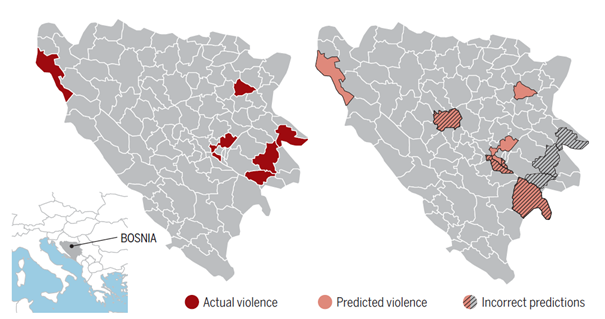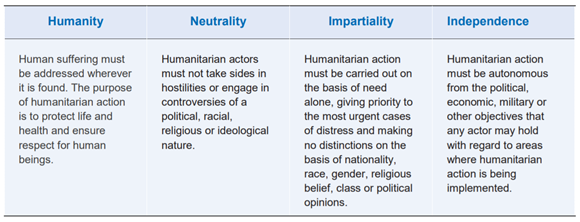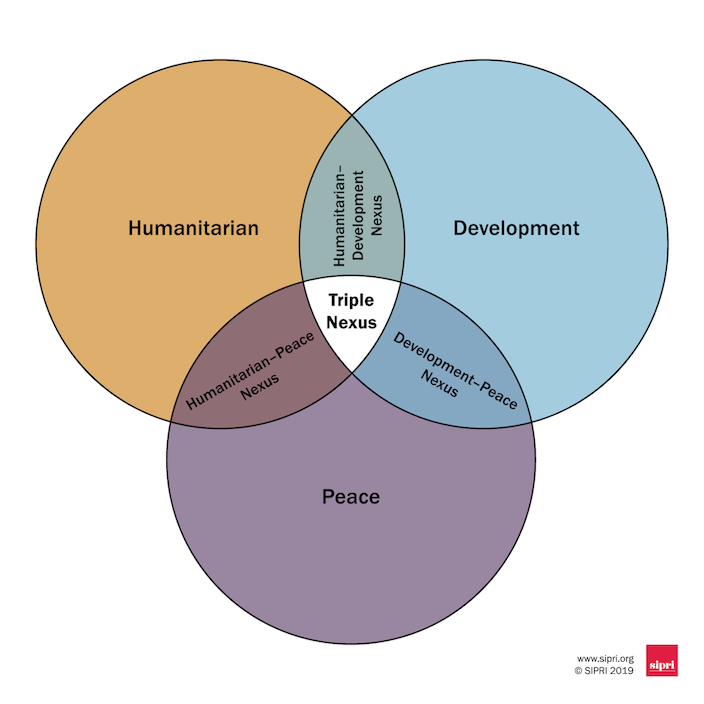Categories
Is anticipatory action in conflict situations compatible with humanitarian principles?
Anticipatory action is a potential game-changer in the humanitarian sector. Current evidence suggests that it is not only much more effective and cost-efficient, but comes with extensive benefits for disaster-affected populations. This provides a clear incentive for humanitarian actors to further invest in current efforts and undertake a general shift, from being a reactive sector to becoming a proactive one.

“Applying FbA to conflict situations could present an invaluable opportunity for saving more lives.”
So far, anticipatory action has been applied mostly in the context of disasters, with technological developments making forecasts of these events increasingly precise. Yet conflicts remain a major driver of humanitarian need. What if we could forecast human behaviour precisely enough to implement anticipatory action in advance of the outbreak of an armed conflict?
The possibility of applying anticipatory action in situations of armed conflict was analysed extensively in a pioneering working paper by Wagner and Jaime (2020), which strongly informed my research. Within the typology presented in this working paper, this research is situated under type 2 of early action: anticipating the humanitarian consequences of armed conflict. Assuming the existence of reliable conflict forecasts, this research conducted a thought experiment to analyse the provision of anticipatory action in conflict situations from a normative perspective. It considers whether the fundamental humanitarian principles of humanity, impartiality, neutrality and independence can be applied in this context, and the issues to which they give rise.
My research focused specifically on the anticipation of armed conflict itself, by means of conflict early-warning mechanisms. Even though an issue-specific angle is taken, the following findings should be seen in the context of broader issues, especially the connections between climate change and conflict (see ICRC, 2020; this is explained further in an endnote to this blog).
An ambivalent performance of anticipatory action under the humanitarian principles

Compatibility with humanity and impartiality
Applying humanitarian principles to the provision of aid based on conflict forecasts paints a divided picture, especially in comparison to traditional, reactive relief. On the one hand, anticipatory action appears to be compatible with the principles of humanity and impartiality. Regarding humanity, anticipatory action aims to save more lives and livelihoods than reactive humanitarian action does. This supports the humanitarian imperative by making humanitarian action more effective.
In terms of the duty to provide impartial, needs-based aid, anticipatory action faces challenges similar to those in reactive crisis response. Limited financial resources curb the ability of humanitarian actors to address the needs of all crisis-affected people. This situation is arguably worse in the case of anticipatory action, and especially in the context of armed conflict, since the majority of funding is still available for post-crisis response.
At the same time, pre-established emergency plans – and hence lower time pressure – decrease the risk of bias in the selection of target groups. The fact that these groups are, ideally, pre-selected and continuously updated could make anticipatory action more impartial than reactive aid. Hence, expanding early action to conflict situations is largely in line with the obligations imposed by the impartiality principle.
Severe challenges for neutral and independent action
On the other hand, however, several problems arise for the provision of (politically) independent anticipatory action. Like reactive humanitarian aid, the anticipatory approach requires diverse funding sources to maintain a degree of independence from external actors, especially donor governments. While this is a well-known issue, the use of forecasts gives rise to several issues that are unique to anticipatory action.
First, which entity is sufficiently independent to pronounce forecasts of armed conflict? Government-based systems are hardly an option that will be considered politically independent, and even specialized research institutes are often government-financed. Ideally, a consortium approach, akin to the Start Network’s FOREWARN group, would insulate a forecast from political interests.
Second, human-based forecasting systems, which currently produce more accurate predictions of conflict than computer-based ones, are not only prone to human bias but also to political interests. Even machine-learning forecasting models cannot be entirely free of bias in the selection and interpretation of datasets.
Most importantly, it is hard to maintain the apolitical character of humanitarian aid in the context of anticipatory action in conflict situations. First, the fact that humanitarian actors mobilise resources in anticipation of a conflict may affect inter-group tensions and potentially lead to an untimely resort to violence by one party to secure a comparative advantage over their adversary. Moreover, there is a realistic possibility of acting in vain (i.e., providing aid without the forecasted conflict actually occurring). Especially where humanitarian actors resort to in-kind and cash assistance, this could be perceived as an illegitimate external intervention to alter the dynamics of a politically tense situation that is forecast to escalate into conflict.
Lastly, the simultaneous use of conflict forecasts for conflict prevention and peacebuilding purposes on the one hand, and anticipatory action on the other, places humanitarianism in very close proximity to highly political actions in the peace sector. At the same time, successful implementation of conflict early action will depend on increased cooperation between the humanitarian and peace sectors (Wagner & Jaime, 2020). Therefore, anticipatory action to address the humanitarian impacts of conflict by using conflict early warning systems has a problematic relation with highly political peace efforts. This endangers its principle to be apolitical and neutral.
The road ahead: two possible scenarios

Abandon anticipatory action for armed conflict
Two possible ways ahead emerge from this analysis. One possibility is that the fundamental humanitarian principles continue to be the central normative yardstick that guides humanitarian action. In this scenario, it must be conceded that anticipatory action to address the humanitarian impacts of armed conflict cannot be implemented without severe challenges to the neutrality and independence of humanitarian actors – unless these actors manage to solve the difficult relation between humanitarianism and politics. Consequently, actors strictly adhering to the fundamental principles are well advised not to engage in anticipatory action for armed conflict, as they are not fully compatible with this approach.
Rethink humanitarianism
A second, and perhaps more likely, possibility is that the role of the fundamental principles for humanitarian practice could change in the future. A current development in the sector is the ‘triple nexus’ idea, which seeks to increase cooperation between the development, humanitarian aid and peace sectors. By default, this implies that the lines distinguishing these sectors will be blurred. Therefore, humanitarianism will increasingly be involved with two sectors that are much more political and whose work is not informed by the four fundamental principles.
Considering this development, it is not unlikely that the role of humanitarian principles will change in the near future, which would make the implementation of anticipatory action to reduce specific risks of conflict more feasible. In fact, the proximity of anticipatory action to the peace sector (as described above) could contribute to the further integration of the humanitarian and peace sectors within the scope of the triple nexus.
Rather than seeing it as incompatible with humanitarian principles, anticipatory action to reduce the humanitarian impacts of armed conflict should be considered as a potential bridge between humanitarian action and peace efforts, and an opportunity to further the nexus idea. However, further research and empirical evidence are needed to test the feasibility of these findings.
This blog post was written by Fabian Halfpap, a postgraduate student of conflict studies at the London School of Economics and Political Science. This blog summarises research insights on normative challenges for providing humanitarian assistance based on forecasts of armed conflict. It is based on his MA thesis, which adds to the debate on the feasibility of expanding anticipatory action to conflict situations, and was written in the framework of the NOHA Master’s Degree in International Humanitarian Action, which is openly accessible here. Fabian can be contacted via LinkedIn.
Endnote
While the focus of this research lies on the humanitarian impacts of conflict, in practice the impacts of conflict cannot be separated from climate-induced humanitarian needs. Competition for scarce natural resources bears the potential of transforming existing tensions into full-scale violence. Climate change, and the risks associated with it, may therefore contribute to the manifestation of armed conflict.
At the same time, existing conflicts have detrimental consequences for the capacity of affected societies to respond to climate-related risks, while increasing their vulnerability. These compound impacts of climate change and armed conflict require more integrated approaches to improve both the short- and long-term resilience of communities affected by climate change and/or armed conflict (ICRC, 2020). The present findings should therefore be considered in light of these compound impacts, suggesting that climate-related risks cannot remain unaddressed in anticipating the humanitarian impacts of armed conflict.
Moreover, the question of anticipation in relation to armed conflict sheds light on the anticipation of conflict-induced displacement, which constitutes a key humanitarian impact of armed conflict, and increasingly of climate change. In fact, it appears that forecasting migration movements is, at this point in time, more feasible than the anticipation of the conflict itself and its humanitarian impacts aside from forced displacement. A recent report by the Danish Refugee Council finds that, by 2022, 7.2 million more persons will be displaced compared to 2020. The report is based on the Foresight model, which predicts following-year displacement with an error margin of merely 6%. This high degree of accuracy increases the utility of its forecasts for humanitarian actors, which stands in contrast to current conflict early warning systems with a much higher margin of error. This suggests that forecasts of specific impacts of armed conflict, such as displacement, are suitable to inform anticipatory action. Nevertheless, it would be even more useful for humanitarian actors to anticipate the very conflicts that cause displacement in the first place.
Hence, the intersecting impacts of armed conflict and climate change as well as the anticipation of conflict-induced displacement are highly relevant to the anticipation of the humanitarian impacts of armed conflict more generally.

